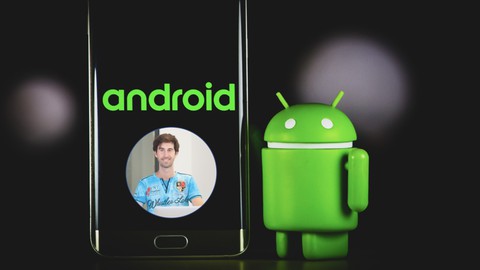
Mastering the Android System Design Interview
Mastering the Android System Design Interview, available at $84.99, has an average rating of 4.04, with 89 lectures, 3 quizzes, based on 80 reviews, and has 5523 subscribers.
You will learn about Practice solving real-world mobile system design interview questions Understand the mobile system design interview process Get to know useful tips and tricks during the interview Understand how to design apps for billions of users Be able to discuss a wide variety of topics including networking, storage, mobile system resources, and much more This course is ideal for individuals who are Android or iOS app developers preparing for interviews at FAANG companies It is particularly useful for Android or iOS app developers preparing for interviews at FAANG companies.
Enroll now: Mastering the Android System Design Interview
Summary
Title: Mastering the Android System Design Interview
Price: $84.99
Average Rating: 4.04
Number of Lectures: 89
Number of Quizzes: 3
Number of Published Lectures: 89
Number of Published Quizzes: 3
Number of Curriculum Items: 92
Number of Published Curriculum Objects: 92
Original Price: €34.99
Quality Status: approved
Status: Live
What You Will Learn
- Practice solving real-world mobile system design interview questions
- Understand the mobile system design interview process
- Get to know useful tips and tricks during the interview
- Understand how to design apps for billions of users
- Be able to discuss a wide variety of topics including networking, storage, mobile system resources, and much more
Who Should Attend
- Android or iOS app developers preparing for interviews at FAANG companies
Target Audiences
- Android or iOS app developers preparing for interviews at FAANG companies
Prepare for and master your mobile system design interview at any of the big tech or FAANG companies, whether it be Google or Apple. Get a detailed walkthrough of several important topics asked in these interviews, and tips and tricks from a Tech Lead of a Google Developer Agency.
Stefan started developing Android apps – almost from Android’s birth – in 2011, and since then had to design and develop a handful of Android, iOS, and Multiplatform apps. During that time he also walked through system design interviews at FAANG companies by himself and therefore wants to share his experience in this course.
Mobile technical interviews at big tech companies are quite challenging and the mobile system design part is often the most unclear and demanding. Many learning resources on the Internet cover backend system design, but there are very limited resources available for mobile system design. This course brings light to mobile system design interviews and gets you prepared for landing your dream job at one of the big tech companies. Despite the course being especially targeted at Android, most concepts are also applicable to iOS.
About 9 hours of on-demand video content will cover what you need to know for your mobile system design interview:
-
Discussion of most important networking concepts, background work, and failure handling
-
Choosing the right networking protocol/technology among polling, web sockets, server-sent events, REST, gRPC, GraphQL, REST, Push Notifications, and more for a given use case
-
Learn about different pagination techniques for large amounts of data
-
Overview of storage typesincluding the file system, preferences, SQL and NoSQL databases, and secure storage, and learn when to use which
-
Learn how to scale your app and backend for billions of users by taking into account the concepts of connectivity, data cost, device ranges, battery consumption, responsive UI, app startup time, and memory footprints
-
Techniques on how to build an offline-capable app
-
Get advice on the process and timing of mobile system design interviews
-
Interview strategies for structuring your mobile system design interview
-
Two extensive mock interviews with real-world mobile system design interview questions, from requirements definition to high-level and detailed design
Course Curriculum
Chapter 1: Introduction
Lecture 1: Introduction
Lecture 2: Download your slides
Chapter 2: Networking
Lecture 1: Networking – Introduction
Lecture 2: HTTP Evolution – HTTP 0.9 & HTTP 1.0
Lecture 3: HTTP Evolution – HTTP 1.1
Lecture 4: HTTP Evolution – HTTP 2.0
Lecture 5: HTTP Evolution – HTTP 3.0 & QUIC
Lecture 6: Client-Server Communication Methods
Lecture 7: HTTP Short Polling & Long Polling
Lecture 8: HTTP Streaming
Lecture 9: Web Sockets
Lecture 10: Server-Sent Events
Lecture 11: REST
Lecture 12: GRPC
Lecture 13: GraphQL
Lecture 14: Push Notifications – Firebase Cloud Messaging
Lecture 15: Pagination
Lecture 16: Further Topics
Chapter 3: Storage
Lecture 1: Storage: Intro
Lecture 2: File System Storage
Lecture 3: SharedPreferences & DataStore
Lecture 4: Databases – SQL vs. NoSQL
Lecture 5: Storing Large Objects (LOBs)
Lecture 6: Secure Storage: Storing Sensitive Data
Lecture 7: Choosing the Right Storage Type
Chapter 4: Build for Billions
Lecture 1: Build for Billions – Introduction
Lecture 2: Connectivity – Networking
Lecture 3: Connectivity – Image Optimization
Lecture 4: Connectivity – Offline Capability
Lecture 5: Data Cost
Lecture 6: Device Ranges
Lecture 7: Battery Consumption
Lecture 8: User Interface
Lecture 9: Doze Mode & App Standby
Lecture 10: App Startup
Lecture 11: Memory
Chapter 5: Interview Strategies
Lecture 1: Interview Strategies – Introduction
Lecture 2: Interview Process & Timing
Lecture 3: Getting to Know, Question & Define Task
Lecture 4: Ask Clarifying Questions
Lecture 5: Gather Requirements
Lecture 6: High Level Design
Lecture 7: Detailed Design
Lecture 8: Questions to the Interviewer
Lecture 9: Final Advice
Chapter 6: Mock Interviews
Lecture 1: Mock Interviews – Introduction
Lecture 2: Chat Application: Q&A
Lecture 3: Chat Application: Requirements
Lecture 4: Chat Application: Try it Yourself
Lecture 5: Chat Application: High Level Design
Lecture 6: Chat Application: Networking Design
Lecture 7: Chat Application: Storage Design
Lecture 8: Chat Application: Sum Up
Lecture 9: Push Notification System: Q&A
Lecture 10: Push Notification System: Requirements
Lecture 11: Push Notification System: Try it Yourself
Lecture 12: Push Notification System: High Level Design
Lecture 13: Push Notification System: Subscriptions
Lecture 14: Push Notification System: Push Notifications & Dispatcher
Lecture 15: Push Notification System: Heartbeats & Network Failures
Lecture 16: Push Notification System: Sum Up
Chapter 7: Google I/O 2023 Additions
Lecture 1: Google I/O 2023: Intro
Lecture 2: Networking: Pagination Testing
Lecture 3: Networking: Pagination Testing Demo
Lecture 4: Storage: Media Permissions
Lecture 5: Storage: Media Permissions Demo
Lecture 6: Storage: Preventing State Loss
Lecture 7: Build for Billions: Running in the Background
Lecture 8: Build for Billions: Per-App Preferences
Lecture 9: Build for Billions: Jetpack Compose
Lecture 10: Build for Billions: Jetpack Compose Demo
Lecture 11: Build for Billions: Splashscreen API
Lecture 12: Build for Billions: Splashscreen API Demo
Lecture 13: Build for Billions: Baseline Profile and Macrobenchmarks
Lecture 14: Build for Billions: Baseline Profile and Macrobenchmarks Demo
Chapter 8: Google I/O 2024 Additions
Lecture 1: Google I/O 2024: Intro
Lecture 2: Google I/O 2024: Overview
Lecture 3: Google I/O 2024: Background Work
Lecture 4: Google I/O 2024: Baseline Profiles & Macrobenchmark API
Lecture 5: Jetpack Compose: API Design
Lecture 6: Jetpack Compose: Phases
Lecture 7: Jetpack Compose: Stability
Lecture 8: Jetpack Compose: Performance
Lecture 9: Demo Part I: Recap & Lookout
Lecture 10: Demo Part II: Startup Benchmark
Lecture 11: Demo Part III: Feature Benchmark
Lecture 12: Demo Part IV: Recompositions
Lecture 13: Demo Part V: Defer Recompositions
Chapter 9: Final Notes
Instructors
-
Stefan Jaindl
Mobile Tech Lead and Instructor at Udemy
Rating Distribution
- 1 stars: 4 votes
- 2 stars: 5 votes
- 3 stars: 9 votes
- 4 stars: 21 votes
- 5 stars: 41 votes
Frequently Asked Questions
How long do I have access to the course materials?
You can view and review the lecture materials indefinitely, like an on-demand channel.
Can I take my courses with me wherever I go?
Definitely! If you have an internet connection, courses on Udemy are available on any device at any time. If you don’t have an internet connection, some instructors also let their students download course lectures. That’s up to the instructor though, so make sure you get on their good side!
You may also like
- Best Software Testing Courses to Learn in December 2024
- Best Big Data Courses to Learn in December 2024
- Best Internet Of Things Courses to Learn in December 2024
- Best Quantum Computing Courses to Learn in December 2024
- Best Cloud Computing Courses to Learn in December 2024
- Best 3d Modeling Courses to Learn in December 2024
- Best Mobile App Development Courses to Learn in December 2024
- Best Graphic Design Courses to Learn in December 2024
- Best Videography Courses to Learn in December 2024
- Best Photography Courses to Learn in December 2024
- Best Language Learning Courses to Learn in December 2024
- Best Product Management Courses to Learn in December 2024
- Best Investing Courses to Learn in December 2024
- Best Personal Finance Courses to Learn in December 2024
- Best Health And Wellness Courses to Learn in December 2024
- Best Chatgpt And Ai Tools Courses to Learn in December 2024
- Best Virtual Reality Courses to Learn in December 2024
- Best Augmented Reality Courses to Learn in December 2024
- Best Blockchain Development Courses to Learn in December 2024
- Best Unity Game Development Courses to Learn in December 2024





















